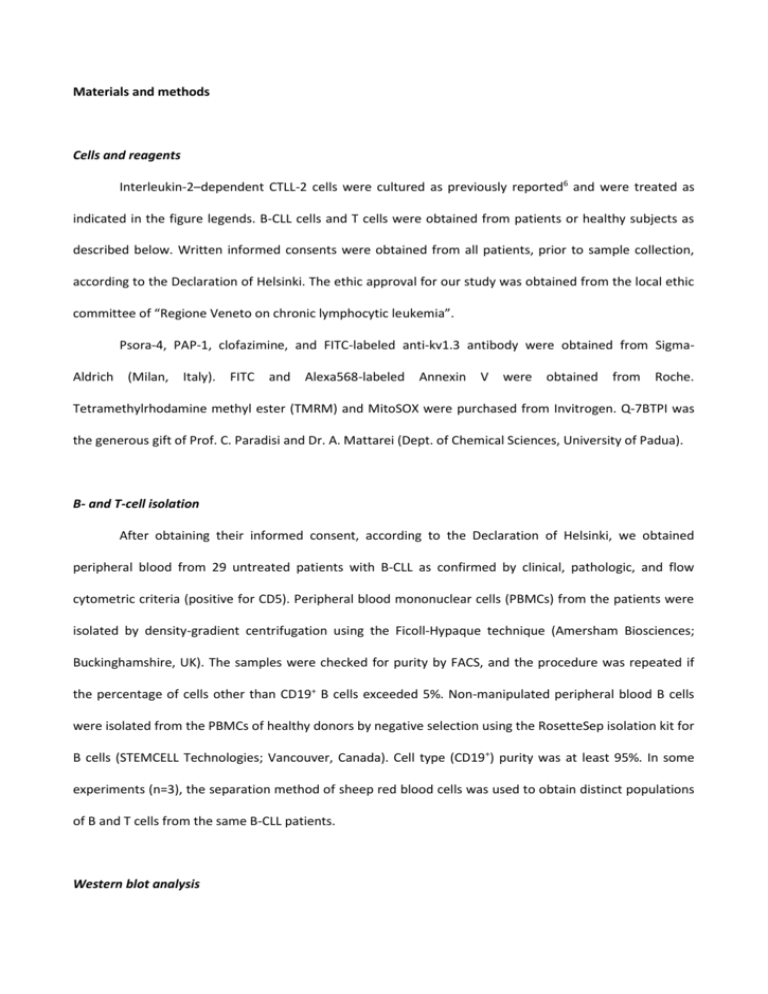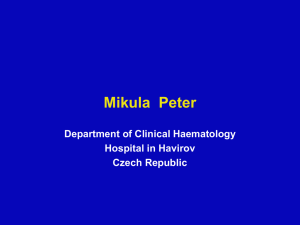Materials and methods
advertisement

Materials and methods Cells and reagents Interleukin-2–dependent CTLL-2 cells were cultured as previously reported6 and were treated as indicated in the figure legends. B-CLL cells and T cells were obtained from patients or healthy subjects as described below. Written informed consents were obtained from all patients, prior to sample collection, according to the Declaration of Helsinki. The ethic approval for our study was obtained from the local ethic committee of “Regione Veneto on chronic lymphocytic leukemia”. Psora-4, PAP-1, clofazimine, and FITC-labeled anti-kv1.3 antibody were obtained from SigmaAldrich (Milan, Italy). FITC and Alexa568-labeled Annexin V were obtained from Roche. Tetramethylrhodamine methyl ester (TMRM) and MitoSOX were purchased from Invitrogen. Q-7BTPI was the generous gift of Prof. C. Paradisi and Dr. A. Mattarei (Dept. of Chemical Sciences, University of Padua). B- and T-cell isolation After obtaining their informed consent, according to the Declaration of Helsinki, we obtained peripheral blood from 29 untreated patients with B-CLL as confirmed by clinical, pathologic, and flow cytometric criteria (positive for CD5). Peripheral blood mononuclear cells (PBMCs) from the patients were isolated by density-gradient centrifugation using the Ficoll-Hypaque technique (Amersham Biosciences; Buckinghamshire, UK). The samples were checked for purity by FACS, and the procedure was repeated if the percentage of cells other than CD19+ B cells exceeded 5%. Non-manipulated peripheral blood B cells were isolated from the PBMCs of healthy donors by negative selection using the RosetteSep isolation kit for B cells (STEMCELL Technologies; Vancouver, Canada). Cell type (CD19+) purity was at least 95%. In some experiments (n=3), the separation method of sheep red blood cells was used to obtain distinct populations of B and T cells from the same B-CLL patients. Western blot analysis Cells (5 × 105 for each assay) were lysed with Tris 50mM, EDTA 5mM, glycerol 10%, SDS 2%, and βmercaptoethanol 1% and were marked with pyronin dye (Sigma-Aldrich; Milan, IT). Proteins from each aliquot were loaded and separated in a 10% SDS-PAGE gel. The material was transferred onto a polyvinyl difluoride (PVDF) membrane (Pall Corporation, Pensacola, FLA, USA) and left there overnight at 4°C. Membranes were incubated with various primary antibodies as described in Leanza et al6. Secondary antibodies (Calbiochem or Santa Cruz Inc.) were conjugated with either horseradish peroxidase or alkaline phosphatase and were detected by chemiluminescence (Pierce) using film (Kodak) or digital imaging on a Bio-Rad ChemiDoc XRS apparatus. Purification of mitochondria from B-CLL cells Mitochondria were purified as previously described6. Briefly, cells were incubated for 30 min on ice in sucrose/TES (300 mM sucrose, 10 mM TES, 0.5 mM EGTA, pH 7.4). Cells were then lysed in a Dounce homogenizer, and the lysate was centrifuged at 600 × g for 10 min at 4°C. The pellet was again processed in the same way so that recovery could be maximized. The combined supernatants were centrifuged once at 600 × g, and the pellet was discarded. The mitochondria-containing supernatant from the last step was centrifuged at 6,000 × g for 10 min at 4°C. The pellet was gently homogenized and suspended in a small volume of TES buffer. A further purification was obtained by centrifugation (8500 × g, 10 min, 4°C) on a discontinuous Percoll gradient (60%, 30%, and 18% Percoll in TES buffer). The floating material was discarded, and the fraction at the lower interface was collected and washed three times by centrifugation at 17,000 × g for 5 min. The final pellet was resuspended in TES buffer. Cell treatment CTLL-2 cells were treated as previously reported6. Next, 1 × 106 B and T cells either from patients or from healthy subjects were incubated with the various compounds (as indicated in figure legends) for 24 hs in a 96-well plate in 200 μL DMEM without serum and phenol red. Psora-4 and PAP-1 were used at 20 M unless otherwise indicated, clofazimine at either 1 or 10 M, as indicated. CSH was used at 4 μM, and probenecid at 50 μM. Cell death detection and double staining After treatment with the various compounds, apoptotic cells were identified by labeling with FITCAnnexin V at 37°C 6. Cells were then collected and analyzed by FACS (FACS Canto II, BD BioSciences). % of dead cells was determined by the sum of counts in Q2 and Q4. In double-staining experiments, treated or control cells were incubated on ice with 0.5 μg of FITC-labeled anti-Kv1.3 antibody for 45 min. Alexa-568Annexin V was then added, and cells were incubated for 20 min at 37°C. Cells were then analyzed for FITC and Alexa-568 fluorescence by FACS. Human PBMCs, purified with Ficoll, were treated for 24 hrs with Probenecid + CSH, Probenecid + CSH + PAP-1, Probenecid + CSH + Psora-4, Probenecid + CSH + Clofazimine. Cells were then washed, stained with FITC-anti-Kv1.3 and APC-Annexin and analysed by FACS. Mitochondrial membrane potential and ROS production Mitochondrial membrane potential was monitored using tetramethylrhodamine methyl ester (TMRM), and ROS production was followed using MitoSOX. CTLL-2 cells, B cells, and T cells were incubated for 20 min at 37°C with either 20 nM TMRM or 1 μM Mitosox and were washed once. After incubation, the desired compounds were added (as indicated in the figure legends), and the decrease in TMR fluorescence or the increase in MitoSOX fluorescence was measured by FACS at various time points over 2 hr 6. Some experiments were performed by pretreating cells with either mitochondria-targeted 0.5 μM Q-7BTPI13 or SOD-PEG (60 U/mL) + CAT-PEG (300 U/mL; both from Sigma) for 30 min at room temperature. In some panels the results are presented as plots of the median of the fluorescence distribution histograms recorded under the various conditions and incubation times, normalized by setting the values measured at time zero as 100%. Electrophysiological experiments Whole-cell currents were recorded with an EPC-7 amplifier (List, Darmstadt, Germany; filter, 1 kHz; sampling rate, 5 kHz) in B cells obtained as described above and cultured in RPMI for a maximum of 24 hr, as described previously8. Leak currents were not subtracted. For whole-cell experiments the bath solution was composed of 150 mM NaCl, 5 mM KCl, 2.5 mM CaCl2, 1 mM MgCl2, and 10 mM HEPES (pH 7.3). The intracellular solution contained 134 mM KCl, 1 mM CaCl2, 2 mM MgCl2, 10 mM EGTA, and 10 mM HEPES (pH 7.3). Intracellular voltages are reported, and outward currents are plotted upward. In vivo experiments in mice For the in vivo experiments Clofazimine was injected i.p. into mice at 5 µg/g body weight following the protocol described in Leanza et al6. Blood was taken 24 hr after injection.











